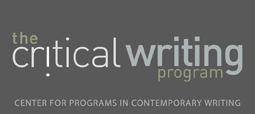Business Economics and Public Policy
An Overview of the Discipline
As of March 1, 2012, Wharton’s Business and Public Policy and Insurance and Risk Management Departments merged to form Business Economics and Public Policy. BEPP employs microeconomics to address and solve policy issues. Most professors specialize in a sub-discipline. For example, Professor Mark Duggan specializes in health economics, and Professor Judd Kessler works on public goods.
Writing in the Discipline
Goal
BEPP research investigates whether or not a certain policy is effective or ineffective, efficient or inefficient, etc.
Reasoning
“BEPP writing is almost always explanation. Persuasion should not be necessary because your results will speak for themselves.” – Professor Kessler
BEPP writing attempts to explain the effects of public policies. However, BEPP writing can become justificatory when a paper critiques a policy or advocates for a new one.
Evidence
All BEPP papers contain primarily quantitative evidence. Within BEPP, there are generally four types of evidence experts consider valid: modeling, empirical research, field experiments, and laboratory settings. When writing in this discipline, incorporating a combination of these types of evidence is necessary if you want to successfully substantiate your claim.Modeling
- Most abstract type of evidence
- Results are generated mathematically
- Complements empirical research
Empirical Research
- Complements modeling
- Analyzes models and data, seeks out patterns or trends
- Critical thinking
Field Experiments
- A scenario is randomized to test a hypothesis
- "Real-world" settings
- Contrasts with laboratory settings
Laboratory Settings
- The environment is controlled in order to test a hypothesis
- "Controlled" settings
- Contrasts with field experiments
Authorship
BEPP research can be conducted individually or collaboratively. Some prefer to write and conduct research on their own, while others prefer work in pairs or teams.
Claims
Every claim in a BEPP paper must be substantiated with quantitative evidence. No claims can be made without including some form of evidence that falls under at least one of the categories described in the evidence section above.
Writing Tips
Important Criteria for Student Papers
- Original ideas
- Reasoning and Evidence
- Mastery of other's ideas
- Organization
Common Errors
A common mistake students make is not explaining or describing their experiments clearly. The design of an experiment needs to explicitly state the conditions and goals it attempts to address. Another mistake is misidentifying the audience, including excessive background distracting the reader or inadequate background inhibiting the reader from fully understanding the main concepts of the paper. EXAMPLES???
Writing Process
Check this sectionMost BEPP papers go through multiple revisions. Earlier revisions focus on “big picture” issues, from editing the paper's structure to reconsidering its core ideas. Later revisions focus on more local issues or, as Professor Kessler describes it, “wordsmithing.” Note that this revision process and overall writing process resembles the writing process utilized in Penn's critical writing seminars.
Genre
Student Assignments
Most lower level courses in BEPP solve problems mathematically. Students usually encounter writing assignments in higher-level or graduate courses. Writing assignments range from a 5-10 page policy paper (such as Duggan's assignment on American Economic Policy) to sections of a journal article. Literature reviews may also be assigned to students because, as Professor Kessler says, "We’re training students to write like economists."
Professional Writing
Click on the professor links to view examples of professional writing in this discipline.
Meet the Professors

Dr. Judd Kessler
"People aren’t as strict about style in Economics writing - it’s mostly preference..." More...

Dr. Mark Duggan
"One common mistake students made on an assignment I gave was..." More...
© 2013 The University of Pennsylvania
